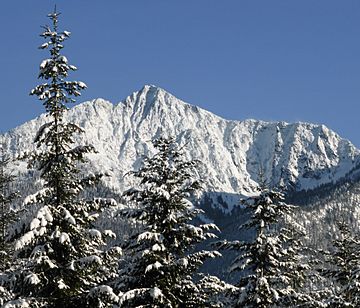Mount Howard (Washington) facts for kids
Quick facts for kids Mount Howard |
|
|---|---|

Mount Howard, west aspect
|
|
| Highest point | |
| Elevation | 7,063+ ft (2,150+ m) |
| Prominence | 2,903 ft (885 m) |
| Isolation | 5.56 mi (8.95 km) |
| Parent peak | Whittier Peak (7,281 ft)> |
| Geography | |
| Location | Chelan County, Washington, U.S. |
| Parent range | North Cascades Cascade Range |
| Topo map | USGS Mount Howard |
| Climbing | |
| Easiest route | scrambling South slope |
Mount Howard is a tall mountain in Washington state, standing at 7,063 feet (2,153 m) (about 2,153 meters) high. It is located west of Lake Wenatchee in Chelan County. This mountain is the highest point on Nason Ridge.
Mount Howard is found between Stevens Pass and Lake Wenatchee. The land around it is part of the Okanogan-Wenatchee National Forest. Rain and melting snow from the mountain flow into the Wenatchee River. Explorers might have named the mountain way back in 1887.
Contents
How Mount Howard Was Formed
The North Cascades mountains, where Mount Howard is located, have very rugged shapes. They feature sharp peaks, long ridges, and deep valleys carved by glaciers. These amazing shapes were created by huge geological events that happened millions of years ago.
Earth's Moving Plates
The history of the Cascade Range goes back millions of years. This was during a time called the late Eocene Epoch. The North American Plate (a giant piece of Earth's crust) slowly moved over the Pacific Plate. This movement caused many volcanic eruptions. For example, Glacier Peak, a large volcano, started forming about 22 mi (35 km) north of Mount Howard.
Small pieces of Earth's crust, called terranes, also helped build the North Cascades. These pieces came together about 50 million years ago. On Mount Howard, you can see a type of rock called gneissic rock from the Nason Terrane.
Ice and Earthquakes
About two million years ago, during the Pleistocene period, huge sheets of ice called glaciers covered the land. These glaciers moved forward and backward many times. As they moved, they carved and shaped the landscape. Most valleys were free of ice by about 12,000 years ago.
The lifting of the land (called uplift) and cracks in the Earth's crust (called faulting) also played a big role. These forces, along with the glaciers, created the tall peaks and deep valleys we see in the North Cascades today.
Weather and Climate Around Mount Howard
Mount Howard is located east of the main Cascade Range crest. This means the area is a bit drier than places to the west. Summers can be warm, and sometimes there are thunderstorms.
Most weather fronts (systems that bring weather changes) start over the Pacific Ocean. They then travel east toward the Cascade Mountains. When these fronts hit the tall peaks of the Cascades, they are forced to rise. This causes them to drop their moisture as rain or snow. This process is called orographic lift.
Because of orographic lift, the western slopes of the Cascades get a lot of rain and snow, especially in winter. During winter, the weather is often cloudy. However, in summer, high-pressure systems over the Pacific Ocean usually bring clear skies with little to no clouds.
Images for kids





